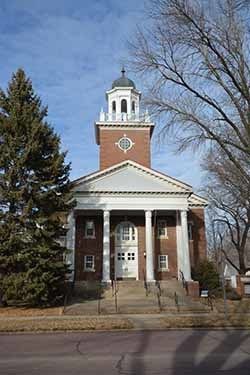
The First Congregational Church in Vermillion was added to the National Register of Historic Places on July 16, the South Dakota State Historical Society has announced.
The National Register is the official federal list of properties identified as important in American history, architecture, archaeology, engineering, and culture. The State Historic Preservation Office of the State Historical Society at the Cultural Heritage Center in Pierre works in conjunction with the National Park Service, which oversees the National Register program, to list the properties.
“South Dakota has a very rich history and culture ranging from prehistoric Indian villages, homesteader cabins, and unique businesses to richly detailed historic neighborhoods – which are all wonderful testaments to our state,” said Ted M. Spencer, State Historic Preservation Officer and director of the State Historic Preservation Office.
Buildings, sites, structures, and objects at least 50 years old possessing historical significance may qualify for the National Register, per the National Park Service guidelines. Properties must also maintain their historic location, design, materials, and association. Listing in the National Register does not place any limitations on private property owners by the federal government.
The First Congregational Church was built in 1928, with its first worship services being held there in November of that year. However, the congregation itself originated many years before that, in 1870.
This church is the congregation’s third building. The first was dedicated in 1873, but it was significantly damaged in the Missouri River flood of 1881. The second building was dedicated in 1882, as the residents of Vermillion were rebuilding their town after the flood.
The First Congregational Church was listed at a state level of significance for its Colonial Revival style of architecture. Though there are still a handful of existing South Dakota churches from the first half of the 20th century that used Colonial elements as this one does, this Vermillion church is especially significant for its close use of traditional New England church designs. The church was an intentional exhibition of the Colonial heritage and architectural traditions of the Congregational denomination.
The building retains a lot of its historic brickwork with its corner quoins, arched multi-light windows, pedimented portico with decorative columns and molding and a center bell tower with ocular windows and octagonal domed cupola. The majority of its primary interior features in the sanctuary and narthex are also original and exemplify its Colonial Revival Style.
For more information on the National Register or other historic preservation programs, contact the State Historic Preservation Office at the Cultural Heritage Center, 900 Governors Drive, Pierre, SD 57501-2217; telephone 605-773-3458 or website history.sd.gov/Preservation (click on National Register of Historic Places in the right column). For information on membership in the State Historical Society, please call 605-773-6000 or email Jeff.Mammenga@state.sd.us.
About the South Dakota State Historical Society
The South Dakota State Historical Society is a division of the Department of Education. The State Historical Society, an Affiliate of the Smithsonian Institution since 2013, is headquartered at the South Dakota Cultural Heritage Center in Pierre. The center houses the society’s world-class museum, the archives, and the historic preservation, publishing, and administrative/development offices. Call 605-773-3458 or visit history.sd.gov for more information. The society also has an archaeology office in Rapid City; call 605-394-1936 for more information.
